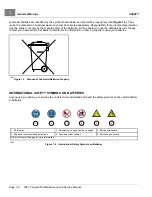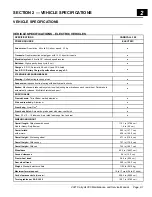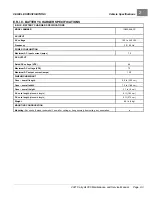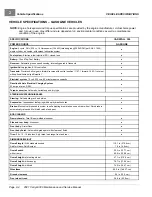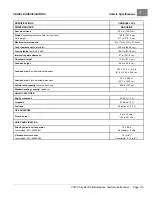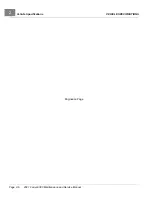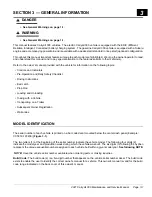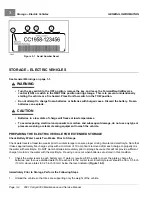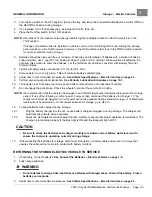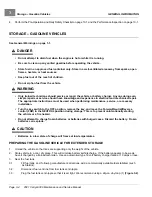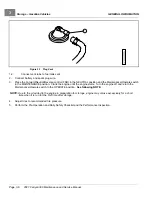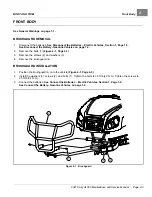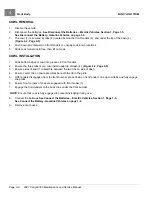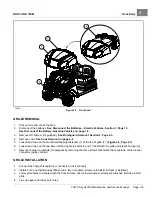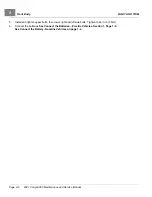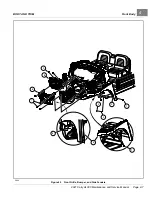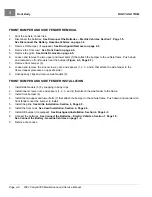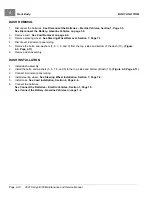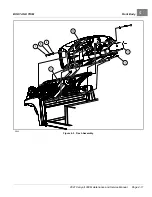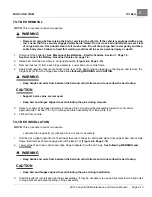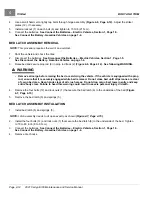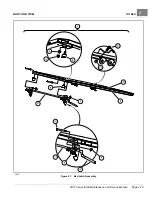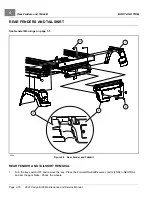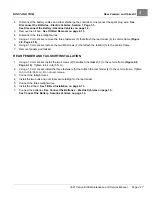
4
Front Body Repair
BODY AND TRIM
CAUTION
• To prevent damage to the vehicle when removing difficult stains or heavy soiling, remove the seat
from the vehicle first.
FRONT BODY REPAIR
See General Warnings on page 1-1.
LIGHT SCRATCHES
1.
Clean entire area to be repaired with clean, clear water.
2.
Using 1200 grit sandpaper, water-sand entire area of scratch until original scratch is no longer visible, either with
finishing sander or wet sanding block. Be sure that sandpaper is centered on sanding pad. Continue to flush with
water while sanding, to increase sandpaper life and keep the sanded surface cool. Wipe repaired area dry and
visually inspect to be sure that the originial scratch has completely disappeared.
3.
Repeat step 2 using 1500 grit sandpaper until all 1200 grit scratches are removed paying close attention to edges.
4.
Install a wool cutting pad (3M #5711 or equivalent) on buffer and spread approx 1/2 tsp. (2mL) of compound
(3M #05955 or equivalent). Buff slowly and steadily over small area so as not to heat surface as this may cause
warping or melting of plastic. Buff sanded area until all sanding scratches have disappeared. Use as much buffing
compound as necessary to achieve this step. If at any time original scratches can be seen, repeat steps 2 and 3
as needed. When all 1500 grit scratches have disappeared, there will be a dull luster over entire area.
5.
Install a foam polishing pad (3M #5725 or equivalent) on buffer and repeat step 4 using approx 1/2 tsp. (2 mL)
buffing compound (3M #5933 or equivalent). Buff compound off until scratches have disappeared. It may be
necessary to apply additional compound to achieve this. The result will be an almost-finished product with a
very high luster and very few buffer swirls.
6.
Using a clean foam polishing pad (3M #5725 or equivalent) and finish glaze (3M #05937 or equivalent), apply a
slightly smaller amount of material than in steps 4 and 5 and buff to desired gloss.
7.
Wipe clean with soft, clean cloth. Any dirt on cloth can mar surface.
ABRASIONS AND HAZE
Abrasions and haze can be greatly minimized by performing steps 5 through 7 above.
LARGE SCRATCHES AND ABRASIONS
Touch-up is not recommended. Replace the entire body part or have it repaired by a professional paint and body
repair shop with experience repairing bodies.
Page 4-2
2021 Carryall 300 Maintenance and Service Manual
Summary of Contents for Carryall 300 2021
Page 2: ......
Page 16: ......
Page 551: ...80 2018 by Kohler Co All rights reserved KohlerEngines com 17 690 15 Rev...
Page 565: ...GASOLINE ENGINE HARNESS Wiring Diagrams Gasoline Engine Harness 26...
Page 566: ...Page intentionally left blank...
Page 567: ...GASOLINE KEY START MAIN HARNESS Wiring Diagrams Gasoline Key Start Main Harness 26...
Page 568: ...Page intentionally left blank...
Page 569: ...GASOLINE PEDAL START MAIN HARNESS Wiring Diagrams Gasoline Pedal Start Main Harness 26...
Page 570: ...Page intentionally left blank...
Page 571: ...GASOLINE INSTRUMENT PANEL HARNESS Wiring Diagrams Gasoline Instrument Panel Harness 26...
Page 572: ...Page intentionally left blank...
Page 573: ...GASOLINE FNR HARNESS Wiring Diagrams Gasoline FNR Harness 26...
Page 574: ...Page intentionally left blank...
Page 575: ...ELECTRIC MAIN HARNESS Wiring Diagrams Electric Main Harness 26...
Page 576: ...Page intentionally left blank...
Page 577: ...ELECTRIC INSTRUMENT PANEL HARNESS Wiring Diagrams Electric Instrument Panel Harness 26...
Page 578: ...Page intentionally left blank...
Page 579: ...ELECTRIC ACCESSORIES HARNESS Wiring Diagrams Electric Accessories Harness 26...
Page 580: ...Page intentionally left blank...
Page 588: ...NOTES...
Page 589: ...NOTES...
Page 590: ...NOTES...
Page 591: ...NOTES...
Page 592: ...NOTES...
Page 593: ...NOTES...
Page 594: ...NOTES...
Page 595: ......
Page 596: ......

